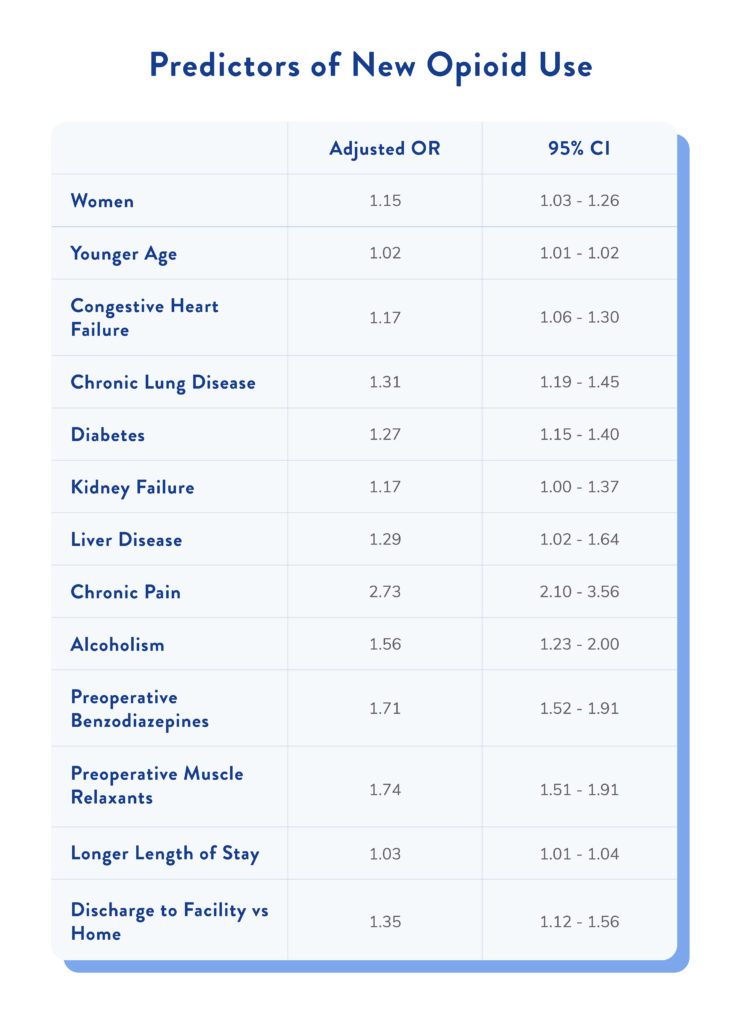Aug 5, 2020 |
TCTMD recently published an article that cited an alarming stat: 1 in 10 cardiac surgery patients are still filling opioid prescriptions between 90 and 180 days after surgery. This stat was published online June 17, 2020, ahead of print in JAMA Cardiology. While opioids can be a useful tool to manage pain and aid recovery, it is clear that the longer a patient is exposed to them, the more likely they are to abuse them. The paper correlates many demographic factors that lead to long term use of opioids, but the clearest correlation is in the amount of oral morphine equivalents (OME, similar to MME) that a patient is discharged with after cardiac surgery.
Post-Op Opioid Monitoring App from Elimu
Elimu’s own Post-op Opioid Monitoring app provides situational awareness of daily MME utilization and calls attention to opportunities to discontinue “just in case” opioids or to prescribe less potent pain medications. Our app is referenced in the article by Dr. Daniel T. Engelman when he states, “It allows us to de-escalate it, to benchmark it, and to make sure that by the time the patient is discharged, they are on the lowest possible OME dose, which this manuscript now has shown correlates with the least possible likelihood of long-term new persistent opioid dependence. About half of patients go home on no opioids. We’d like to make that zero.”
We highly recommend reading the article in its entirety here. If you don’t have time, we’ve pulled out some interesting highlights from the article below.
- Enhanced recovery after surgery (ERAS) protocols that include opioid minimization are gradually being embraced by cardiothoracic surgeons, but challenges related to patient education and documentation of the total amount of opioids given to patients in the hospital remain
- Patients who were prescribed more than the median 300 mg OME value (approximately 40 tablets of oxycodone 5mg) at discharge were at an increased, dose-dependent risk of developing new persistent opioid use
- None of the included patients had taken opioids within 180 days before their surgery and all filled an opioid prescription within 14 days after their procedure
- CABG patients were also more likely to refill their prescriptions within 180 to 270 days
- Other risk factors for developing new persistent opioid use were diverse, with a prior history of chronic pain nearly tripling the likelihood of persistent use
Situational awareness is key to reducing opioid utilization
Many of the physicians in the article have quotes that point to awareness among doctors as being key to better managing opioids. However, it’s not easy to bring about change simply by communicating ideals at different intervals. The pressures of daily clinical life and treating patients removes the luxury of time and going above and beyond. Calculating OME or MME is extremely time-consuming, yet critical in decision making when attempting to reduce opioid utilization while also balancing pain management and recovery.
Having an app that does all of the heavy lifting in a timely manner makes it easy for clinicians to incorporate MME data into their decision making. Bringing situational awareness – what has been prescribed, how much has been administered, what’s typical for this type of surgery, what isn’t being utilized? is an essential component to better opioid prescribing practices and patient safety.

